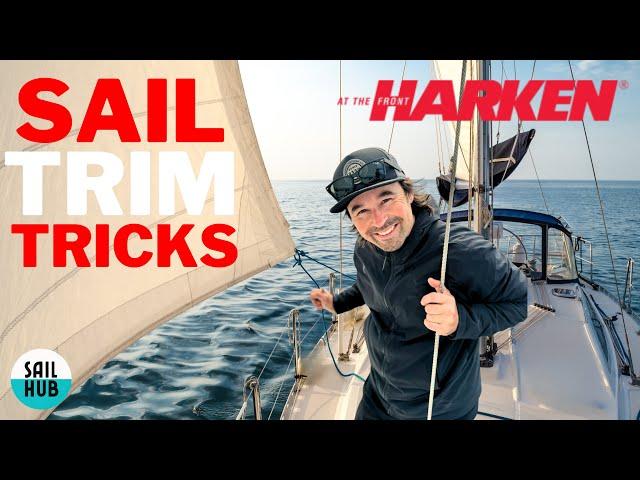
3 Simple sailing tips to Relax your boat and crew.
Комментарии:

First! 🥳
Ответить
Another great video Chris.
Ответить
Guess I'll just be the third, a solid Bronze Medal hehe
Amazing video Guys : ), so many good tips !!!!

Really helpful. When we launch later this year we will have all new sails and running rigging. We will use variations of all these.
We do have a solid kicker so it will be a bit different setup.
We are moving to a cutter rig and have removed the 50 year old worn out (and leaking) Genoa track. Going to be creating our own 4D sheet control.
Our Yankee is a continuous line furler so the route for the lines are critical.
We also need a new mizzen sheet setup (it really didn't work before). We want to create a soft dyneema "track" for it.
Not sure about the mainsheet yet. It used to come to a single deck point just aft of the wheelhouse. I'd love a high level track but construction, cost and space are issues.

Aagh Chris - I love your work - I have been tugging on that leach line - and then letting it go - why the fu** have I got that curl in my main... I learned heaps - thanks mate - so when I sail into bonny Scotland - where do I come to find ya?? Oh compliments to the camera woman - great stuff gal.. Give that gal a Bells..
Ответить
Wonderful episode rigging and testing in the real World, so we can see how this stuff works.
Ответить
Have you finished that van conversion yet? Seems to have gone off the radar
Ответить
Solid, basic, low cost, modern but low tech fixes for everyday issues. Well done.
Ответить
Question I hope someone can help me with... I'm starting my search for a boat. 30ish feet range. It seems that many boats are either a narrow beam so they want to heel easily, or a wide beam so the tend to beat you up in poor weather. Is there some sort of 'ideal' beam width, or ratio of length to width that hits the sweet spot of wide enough to be stable, narrow enough to slice through rough seas?
Any other info would also be appreciated. Thank you for your time.

Great video, looking forward to the imoca discussion to learn about their handling systems
Ответить
Very helpful, especially the headsail adjustment. I don’t have extruded rail with “holes” to move the bottom block, but the concept makes sense. You guys are friends with Dan & Kika, how would you go about this with Uma (no rails at all). Add some carefully places padeyes?
Ответить
Great tips!
Ответить
I wish people would not invent their own terms for technical things which already have a perfectly adequate choice of terms. "Curl" of a leech has has for my entire life meant only one thing: that's the curl to windward (sometimes called "cupping") you get in this part of the sail when you overtighten the leech line.
(Many old sails permanently exhibit this curl no matter how you set them, because the leech tabling, having more layers of cloth, does not stretch over time as much as the body of a well-used sail)

Do you have any links to how to get, or make the cascade system kicker adaptation with dyneema? If so id love to have that!!! Great video, thank you
Ответить
Thanks for the great info! We'll make sure to note this for future reference when we start our cruising adventures!
Ответить
Faaaaaantaaaaaaaaaaasssstickkkkk. Loved it. So many lovely tidbits in this video. Packed with info.
Ответить
Like the rings.
Ответить
Thanks!
Ответить
Thanks. Great info and well explained!
Ответить
Grey tips we used the cascade on big race boats and it is a great way to depower a main quickly. I would lead the line back to the cockpit to avoid having to go forward. Likewise snatch blocks and ways to trim the Genoa are also great. Claire Francis sailed her Ohlson 38 in the OSTAR and broke the record for a woman solo. Boat was sold not so long ago and as you can imagine the name was controversial in recent years.
Ответить
Thanks! That was clear and helpful. (That simple phrase doesn't convey my enthusiasm - this was great!) I'm definitely subscribing and sending the link to my daughters who are about to begin cruising.
Ответить
Any chance you connected the load cell to the line on the boom? :)
I've been confused about kicker and vang so just asked Google Gemini and it says what you created is a vang, and a kicker is what holds the boom up when the sail is down, which sounds like a topping lift, confusing me even more because Wikipedia says vang is US and kicker is UK and they are the same thing. I can see how a telescopic tube with a spring in it can kick to lift a boom when you let out line, and you pull on a line to vang the boom down, or with a hydraulic ram also kick and vang, but I can't see how a line and pulleys can kick, the sail has to do the kicking because apparently a topping lift isn't considered a kicker... I just asked Claude and it also says Vang is a line that applies downward force to the boom when the sail is up, and a Kicker is a line that applies upward force to the boom when the sail is up, and a leech or reef lines aren't kicker. I feel like I've been kicked in the vang. GPT-4o says there's no difference. I can see that if you didn't have a topping lift you'd want a kicker when the sail is down, but when the sail is up the sail can do the kicking. :) Does kicking strap originally come from horse rigging? Pulling the butt of the horse down to the carriage shafts? So the horse's butt is the sail and the carriage shafts the booms? The strap pulling up on when the horse kicked. I really did get kicked in the vang researching this one.

This is a very good video! Even for the keen sailor this is very useful. Might get some of these snatch blocks. What diameter would be good for a 36ft and what loads are we looking at ? Did you use a friction ring below the snatch block? Great content guys, good sail trim and awesome hardware!
Ответить
Great tips. 🔥🔥🔥
Ответить
Great video...I was thinking to do the same. How did you attach the ring onto the stanchion exactly; did you splice 2 mm dyneema and put it around a ring and then attached it with few turns around stanchion? Or?
Thx a mil.

Thanks!
Ответить
How did you run the line attached to the Harkin snatch block through the toerail?
Ответить
nice and simple! It always seems so obvious once you see someone who knows what to do, do it.
Ответить
Barbour hauling the jib is an absolute must when cracked off the wind. Moving the sheeting position outboard to the rail and a little forward not only allows the jib to be trimmed right but also opens the slot with the mainsail so that the slot is not choked and cause excessive backwinding on the main. It allows a far better overall trim for faster sailing. I would say running a clip-on new sheet from a block on the rail is best. We use a snap shackle snatch block. if you are sailing for any length of time on a shy white sail reach this is a must do. You will be amazed at the difference it makes.
Ответить
This video is another reason that I love this channel...I just learned more great information and tricks!!!!! Thanks again for another great video!! Two more weeks to launch and then try the new tricks. See you next week.
Ответить
Gotta say Love that i found this channel!!! Chris is a great presenter and the way he explains things and his great persona lends to the easy understanding on sometimes hard to understand things especially for new to sailing folks, kudos
Ответить
wow .. Learnt a lot . Thanks Chris
Ответить
Do you have a safe rig tip for heaving to with a self tacker
(Factory Hanse) ?
For both tacks and fed back to cockpit?
There are a couple of deck d's adjacent and either side of the track.

Great tips thanks, I am going to try using a snatch block on my Legend 33, easier to use than a pole in stronger winds downwind.
Ответить
Just found your channel. Love it your channel should be must watch for sailors imo
Ответить


























